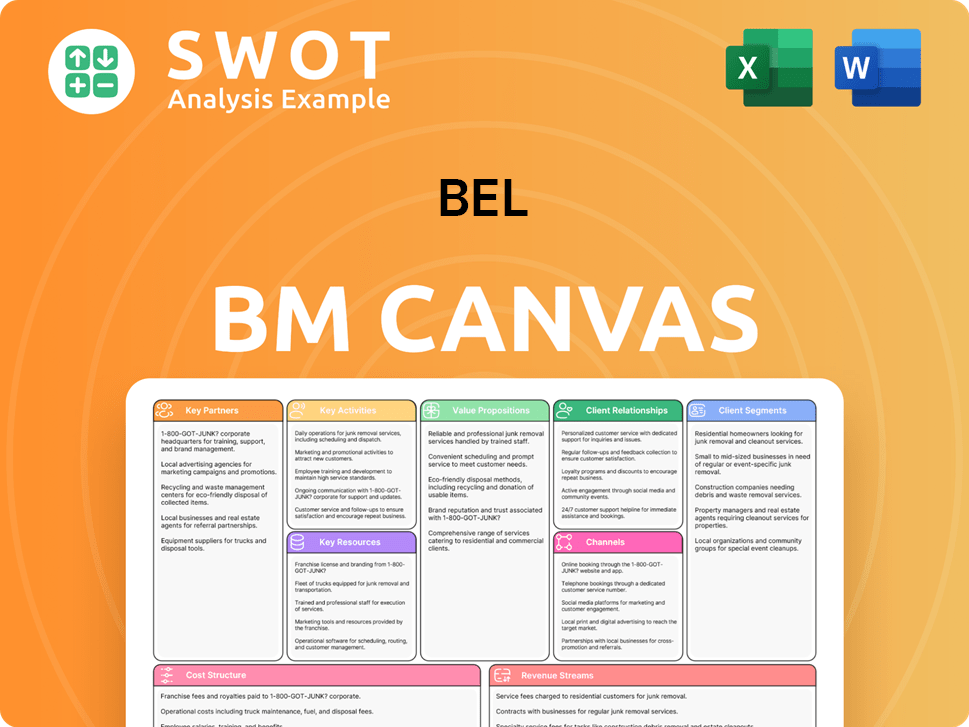Bel Bundle
Can Bel Company Maintain Its Cheese Crown?
The global cheese market is a battleground of flavors and brands, constantly reshaped by consumer tastes and innovation. Bel SWOT Analysis provides a deep dive into the strategies of a cheese industry leader. From its origins in France to its global presence, Bel Company has carved a significant niche for itself. But who are its rivals, and how does it stay ahead?

This exploration of the Bel Company competitive landscape will analyze its market position, examining its key brands and how they stack up against the Bel cheese competitors. We'll dissect the Bel Group market analysis, revealing the company's competitive advantages and the challenges it faces in the dynamic dairy market. Understand the competitive strategies of Bel Group and its global presence, providing insights for investors, analysts, and anyone interested in the cheese industry.
Where Does Bel’ Stand in the Current Market?
The company holds a strong market position in the global cheese industry, particularly in portioned and snacking cheese. While specific market share figures for 2024-2025 are still emerging, the company's consistent presence and brand recognition indicate a significant hold. The company's primary product lines, including The Laughing Cow, Mini Babybel, and Kiri, are leaders in their respective categories, catering to diverse customer segments.
In 2023, the company recorded sales of €3,570 million, demonstrating its substantial scale within the market. The company's strategic focus on international expansion has allowed it to penetrate various markets, including North America, Europe, and Asia. Over time, the company has strategically shifted its positioning to emphasize healthier, more sustainable, and plant-based offerings, reflecting evolving consumer preferences.
The company's financial performance, as evidenced by its 2023 sales, underscores its robust health compared to many industry averages, allowing for continued investment in innovation and market expansion. The company holds a particularly strong position in markets where its iconic brands have established deep consumer loyalty and widespread distribution networks. For a deeper understanding of the company's target audience, consider reading about the Target Market of Bel.
The company's market share in the global cheese industry is significant, especially in the portioned and snacking cheese segments. In 2023, the company reported sales of €3,570 million, reflecting its strong revenue base and market presence. This financial performance enables continued investment in innovation and market expansion, strengthening its competitive position.
The company has a widespread global presence, with products sold in over 120 countries. Its strategic focus on international expansion has allowed it to penetrate various markets, including North America, Europe, and Asia. This broad geographic footprint supports the company's overall market position and revenue generation.
The company's primary product lines, including The Laughing Cow, Mini Babybel, and Kiri, are leaders in their respective categories. These iconic brands have established deep consumer loyalty and widespread distribution networks. The diverse product portfolio caters to various customer segments, from children to adults, seeking convenient and healthy snack options.
The company has strategically shifted its positioning to emphasize healthier, more sustainable, and plant-based offerings. This includes initiatives like the expansion of its plant-based cheese alternatives, aligning with the growing demand for sustainable food options. This focus on innovation helps the company maintain its competitive edge in the evolving market.
The company's competitive advantages stem from several factors, including strong brand recognition, a diverse product portfolio, and a global distribution network. These elements contribute to its robust market position and ability to compete effectively in the cheese industry.
- Brand Loyalty: Strong consumer loyalty to iconic brands like The Laughing Cow and Mini Babybel.
- Product Diversity: A wide range of products catering to different consumer preferences and needs.
- Global Presence: Products sold in over 120 countries, ensuring broad market reach.
- Innovation: Continuous innovation in product offerings, including plant-based alternatives.
Bel SWOT Analysis
- Complete SWOT Breakdown
- Fully Customizable
- Editable in Excel & Word
- Professional Formatting
- Investor-Ready Format

Who Are the Main Competitors Challenging Bel?
The competitive landscape for the company is intense, shaped by a mix of large multinational corporations, regional players, and emerging businesses. The cheese industry, where the company operates, is a global market with significant competition. Understanding the key competitors is crucial for assessing the company's market position and strategic challenges.
The company faces both direct and indirect competition. Direct competitors primarily include other major food and dairy companies that have significant cheese portfolios. Indirect competition comes from the broader snacking industry and the rise of plant-based alternatives, which offer consumers a wider variety of choices.
For a detailed look at the company's business model and revenue streams, you can check out this article: Revenue Streams & Business Model of Bel.
The primary direct competitors include large dairy and food companies with extensive cheese product lines. These competitors often have established global distribution networks and strong brand recognition.
Lactalis is a major French multinational dairy product corporation. It is a formidable rival due to its vast range of cheese brands and a strong global distribution network. In 2023, Lactalis reported revenues of approximately €28.3 billion.
Groupe Savencia Fromage & Dairy, another French company, is a direct competitor. It competes through its extensive selection of specialty cheeses. Savencia's revenue in 2023 was around €6.9 billion.
Numerous regional and local cheese producers also pose a threat, especially in specific geographic markets. These producers may have strong brand recognition and established distribution channels within their regions.
In the United States, Kraft Heinz is a significant competitor, particularly with its Philadelphia cream cheese brand. Kraft Heinz's net sales in 2023 were approximately $26.6 billion.
Sargento, known for its shredded and sliced natural cheeses, also competes in the U.S. market. Sargento's market share in the shredded cheese segment is substantial, though specific revenue figures are not publicly available.
Indirect competition comes from the broader snacking industry. The rise of plant-based alternatives and niche artisanal cheeses also impacts the competitive landscape.
- Savory Snacks: Products like chips, crackers, and pretzels compete for consumer snacking occasions.
- Yogurt and Other Convenient Foods: Yogurt and other ready-to-eat items offer consumers quick and healthy alternatives.
- Plant-Based Alternatives: The growing market for plant-based cheeses presents a challenge to traditional dairy products. The plant-based cheese market is expected to reach $4.5 billion by 2025.
- Artisanal Cheeses: Niche artisanal cheese producers can attract consumers seeking unique and high-quality products.
Bel PESTLE Analysis
- Covers All 6 PESTLE Categories
- No Research Needed – Save Hours of Work
- Built by Experts, Trusted by Consultants
- Instant Download, Ready to Use
- 100% Editable, Fully Customizable

What Gives Bel a Competitive Edge Over Its Rivals?
The competitive advantages of the company, a prominent player in the dairy market, are rooted in its strong brand equity, extensive distribution, and innovation in the cheese industry. Brands like The Laughing Cow, Mini Babybel, and Kiri have established global recognition, building consumer trust and loyalty. This solid brand foundation allows the company to command premium pricing and maintain a strong market presence. The company's strategic focus on portioned and snacking cheese formats has also set it apart, catering to evolving consumer preferences.
The company's widespread distribution network, spanning over 120 countries, ensures its products are easily accessible to a vast consumer base. This extensive reach is a significant advantage over smaller competitors. The company also benefits from economies of scale in production and procurement, which provide a cost advantage, enabling competitive pricing while maintaining profitability. The company has been proactively investing in plant-based alternatives, leveraging its existing brand recognition to enter new and growing market segments. These advantages have evolved over time, with the company continuously adapting its product development and marketing strategies to reinforce its position.
The company's commitment to sustainable practices and responsible sourcing further enhances its brand image and appeals to environmentally conscious consumers. The company faces potential threats from imitation by competitors and shifts in consumer preferences that could undermine traditional cheese consumption. For a deeper dive into the company's growth strategy, consider reading this article on Growth Strategy of Bel.
The company's brands, including The Laughing Cow and Mini Babybel, have achieved global recognition and consumer trust. This strong brand equity allows the company to maintain premium pricing and secure shelf space. Customer loyalty is a key factor, particularly in the competitive cheese industry, supporting consistent sales and market share.
The company's products are available in over 120 countries, providing widespread accessibility to consumers. This extensive distribution network is a significant advantage, ensuring its products reach a vast global audience. This broad reach helps the company compete effectively in the dairy market against both local and international rivals.
The company has consistently innovated in portioned and snacking cheese formats, catering to changing consumer preferences. This focus on convenience and healthier options differentiates the company from competitors. This innovation helps maintain relevance and attract new consumers in the dynamic cheese industry.
The company benefits from economies of scale in production and procurement, leading to cost advantages. These efficiencies enable competitive pricing while maintaining profitability. This cost-effectiveness is crucial for competing in the dairy market and managing financial performance compared to competitors.
The company's competitive advantages are multifaceted, encompassing strong brand recognition, extensive distribution, and strategic innovation. These elements work together to create a resilient market position.
- Brand Strength: Globally recognized brands like The Laughing Cow, Mini Babybel, and Kiri drive customer loyalty and premium pricing.
- Global Reach: Distribution in over 120 countries ensures broad market access.
- Innovation: Focus on portioned and snacking formats meets evolving consumer needs.
- Cost Efficiency: Economies of scale provide a competitive cost structure.
Bel Business Model Canvas
- Complete 9-Block Business Model Canvas
- Effortlessly Communicate Your Business Strategy
- Investor-Ready BMC Format
- 100% Editable and Customizable
- Clear and Structured Layout

What Industry Trends Are Reshaping Bel’s Competitive Landscape?
The competitive landscape for Bel Company is significantly influenced by evolving industry trends, presenting both challenges and opportunities. The company's position in the dairy market is subject to shifts in consumer preferences, technological advancements, and regulatory changes. Understanding these dynamics is crucial for assessing Bel's future outlook and strategic direction.
Risks include intensified competition and economic pressures, while opportunities lie in product innovation and market expansion. Bel Company's ability to adapt to these factors will determine its success in the global cheese industry. The company's strategic responses, including diversification and sustainability initiatives, will be key to maintaining its market position.
The cheese industry is experiencing a surge in demand for plant-based alternatives, driven by health and sustainability concerns. Snacking and on-the-go consumption habits are also on the rise, aligning with Bel's core product formats. Technological advancements in food processing and packaging are creating opportunities for innovation.
Intensified competition from established players and new entrants in the plant-based sector poses a threat. Regulatory changes related to food labeling and sustainability could require adjustments to production processes. Global economic shifts, including inflation and supply chain disruptions, may impact raw material costs and consumer spending.
Significant growth potential exists in emerging markets where cheese consumption is increasing. Further product innovations, catering to specific dietary needs and flavor preferences, present opportunities. Strategic partnerships and expansion into new markets can also drive growth.
Bel Company is investing in research and development for new products, including plant-based options. Strategic partnerships are being formed to expand reach and capabilities. The company maintains a strong focus on its brand portfolio, and it is embracing sustainability initiatives to adapt to market changes.
Bel's strategy involves balancing traditional dairy products with innovative plant-based options to remain relevant. The company's competitive position is evolving to encompass a more diversified portfolio. This approach aims to ensure sustained growth and adaptability in the changing food landscape. For a deeper dive into the company's structure, you can refer to a detailed analysis of the company's structure.
- Continued investment in R&D to drive innovation in both dairy and plant-based products.
- Strategic partnerships to enhance market reach and expand product offerings.
- Focus on sustainability to meet consumer demands and regulatory requirements.
- Expansion into emerging markets to capitalize on growing cheese consumption.
Bel Porter's Five Forces Analysis
- Covers All 5 Competitive Forces in Detail
- Structured for Consultants, Students, and Founders
- 100% Editable in Microsoft Word & Excel
- Instant Digital Download – Use Immediately
- Compatible with Mac & PC – Fully Unlocked

Related Blogs
- What are Mission Vision & Core Values of Bel Company?
- What is Growth Strategy and Future Prospects of Bel Company?
- How Does Bel Company Work?
- What is Sales and Marketing Strategy of Bel Company?
- What is Brief History of Bel Company?
- Who Owns Bel Company?
- What is Customer Demographics and Target Market of Bel Company?
Disclaimer
All information, articles, and product details provided on this website are for general informational and educational purposes only. We do not claim any ownership over, nor do we intend to infringe upon, any trademarks, copyrights, logos, brand names, or other intellectual property mentioned or depicted on this site. Such intellectual property remains the property of its respective owners, and any references here are made solely for identification or informational purposes, without implying any affiliation, endorsement, or partnership.
We make no representations or warranties, express or implied, regarding the accuracy, completeness, or suitability of any content or products presented. Nothing on this website should be construed as legal, tax, investment, financial, medical, or other professional advice. In addition, no part of this site—including articles or product references—constitutes a solicitation, recommendation, endorsement, advertisement, or offer to buy or sell any securities, franchises, or other financial instruments, particularly in jurisdictions where such activity would be unlawful.
All content is of a general nature and may not address the specific circumstances of any individual or entity. It is not a substitute for professional advice or services. Any actions you take based on the information provided here are strictly at your own risk. You accept full responsibility for any decisions or outcomes arising from your use of this website and agree to release us from any liability in connection with your use of, or reliance upon, the content or products found herein.